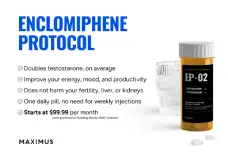You are using an out of date browser. It may not display this or other websites correctly.
You should upgrade or use an alternative browser.
You should upgrade or use an alternative browser.
Forum list
How to Use This Forum and Introductions
Introductions
Introduce yourself to the expert community
- Threads
- 1.1K
- Messages
- 7.8K
Sub-forums
Sub-forums
- Threads
- 1.1K
- Messages
- 7.8K
- Threads
- 78
- Messages
- 336
Testosterone Replacement, Low T, HCG, & Beyond Testosterone Replacement, Low T, HCG, & Beyond
- Threads
- 164
- Messages
- 170
- Threads
- 7.3K
- Messages
- 92.6K
Testosterone Side Effect Management
anastrozole hcg TRT, estradiol, high hematocrit, TRT acne, and more
- Threads
- 2.9K
- Messages
- 40.9K
- Threads
- 2.9K
- Messages
- 40.9K
hCG, Clomid & Others for Fertility, PCT or Low T
- Threads
- 729
- Messages
- 7.7K
- Threads
- 729
- Messages
- 7.7K
- Threads
- 1.8K
- Messages
- 20.7K
Blood Test Discussion
You can post your blood work in image format for others to see and discuss
- Threads
- 2.8K
- Messages
- 30.5K
- Threads
- 2.8K
- Messages
- 30.5K
Testosterone and Men's Health Articles
Testosterone and Men's Health Articles
- Threads
- 2K
- Messages
- 9.5K
Sub-forums
Sub-forums
- Threads
- 2K
- Messages
- 9.5K
Prostate Related Issues
Latest information about testosterone and the prostate gland
- Threads
- 614
- Messages
- 4.4K
- Threads
- 614
- Messages
- 4.4K
- Threads
- 25
- Messages
- 150
Resources and Suppliers
Where to buy syringes, ED drugs, and more
- Threads
- 276
- Messages
- 2.3K
Sub-forums
Sub-forums
- Threads
- 276
- Messages
- 2.3K
ExcelMale.com Advertisers
This is a list of companies that advertise on ExcelMale.com.
- Threads
- 2
- Messages
- 2
- Threads
- 2
- Messages
- 2
General Health & Fitness Nutrition, Exercise, Supplement & Mental Health
Workouts & Routines
Best exercise information to increase muscle and lose fat
- Threads
- 264
- Messages
- 2.6K
- Threads
- 264
- Messages
- 2.6K
- Threads
- 1.6K
- Messages
- 11.1K
Nutrition and Supplements
Nutrition and supplements for fat loss, muscle gain, energy, ED, and much more
- Threads
- 1.4K
- Messages
- 12.3K
- Threads
- 1.4K
- Messages
- 12.3K
- Threads
- 253
- Messages
- 2.4K
Thyroid, Pregnenolone, Progesterone, DHEA, etc
Thyroid, DHEA, Pregnenolone, Progesterone, etc
Latest information on DHEA, pregnenolone, progesterone, prolactin, etc
- Threads
- 836
- Messages
- 9.7K
- Threads
- 836
- Messages
- 9.7K
Peptide Forums (GHRH, Sermorelin, etc)
- Threads
- 406
- Messages
- 4.2K
Clinical Use of Anabolics and Hormones nandrolone, oxandrolone, and more
Clinical Use of Anabolics and Hormones
Nandrolone, oxandrolone, and hormones used clinically for wasting and recovery
- Threads
- 278
- Messages
- 6K
- Threads
- 278
- Messages
- 6K
ExcelFemale Information about HRT for women
HRT in Women
Information about testosterone and hormone replacement therapy for women
- Threads
- 523
- Messages
- 2.9K
- Threads
- 523
- Messages
- 2.9K
Expert Interviews
Questions for Specific Doctors & Experts
Questions directed specific doctors or experts only. Do not post here for questions to the forum.
- Threads
- 118
- Messages
- 1.8K
- Threads
- 118
- Messages
- 1.8K
Expert Interviews
Interviews with doctors, pharmacists, clinic owners, dietitians, exercise trainers, supplement experts, etc
- Threads
- 49
- Messages
- 483
- Threads
- 49
- Messages
- 483
Health Petitions and Advocacy Take Action and Protect Your Access
Add and Read Reviews
Doctor and Clinic Reviews
The best and not so good TRT clinics in the US and overseas
- Threads
- 279
- Messages
- 2.4K
- Threads
- 279
- Messages
- 2.4K
Compounding Pharmacy Product Reviews
The best compounding pharmacies in the US and other countries
- Threads
- 80
- Messages
- 901
- Threads
- 80
- Messages
- 901
- Threads
- 23
- Messages
- 312
- Threads
- 41
- Messages
- 323
- Threads
- 27
- Messages
- 151
- Threads
- 28
- Messages
- 213
Other Men's Health Product or Company Reviews
Reviews about other men's health products or companies
- Threads
- 23
- Messages
- 173
- Threads
- 23
- Messages
- 173
La Testosterona (En Español )
- Threads
- 33
- Messages
- 112
Excel Male Lounge Forums
The Hang Out - Where Everything Goes!
Where you can discuss any male related issues
- Threads
- 417
- Messages
- 3K
- Threads
- 417
- Messages
- 3K
Participate in Surveys Share and learn what others do or think
- Threads
- 4
- Messages
- 19
Staff online
-
SadikBhimaniAdministrator
Latest posts
-
Building a TRT protocol around hCG
- Latest: Nelson Vergel
-
Why Use hCG With TRT?- A Clinical Review
- Latest: Nelson Vergel
-
-
-
-
-










